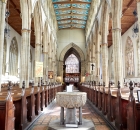Heating — ancient and modern for Hull church

The largest parish church in England and a Grade 1 listed building, Holy Trinity Church in Hull, is now heated by an Imax Xtra EL 620 kW floor-standing condensing boiler from Ideal Commercial boilers. It was installed as part of a major overhaul of the heating system which was itself part of a £4.5 million project to transform the church into an events venue for Hull being the UK City of Culture in 2017.
The previous boilers had failed, and the church was being heated by a temporary boiler house.
Removing the old boilers from the basement plant room was a major operation as the boiler frames had been cast into supporting stone walls. A stonemason supported the ceiling and arches in the plant room before removing the stone from around the old boiler frames, freeing the appliances and rebuilding the supporting arches. The new boiler was manoeuvred onto the new boiler base via a specially constructed ramp.
Ideal Commercial Boilers supplied and fitted additional controls — including a plant-room sensor, outdoor sensor and a programmer.
The church dates back to around 1300 and contains some of the finest mediaeval brickwork in the country, particularly in the transepts. William Wilberforce, who led the parliamentary campaign against the slave trade, was baptised there.








